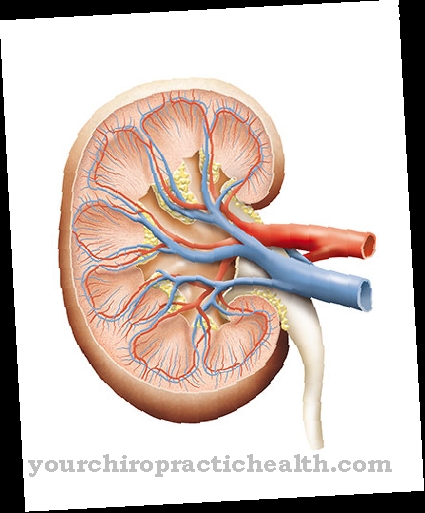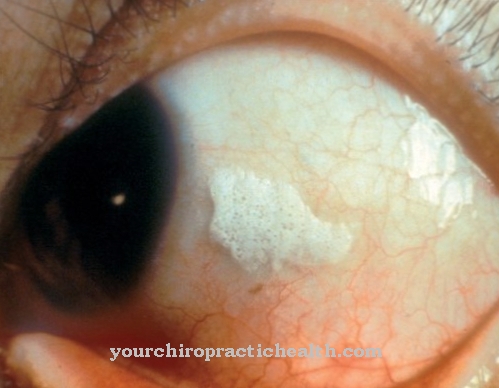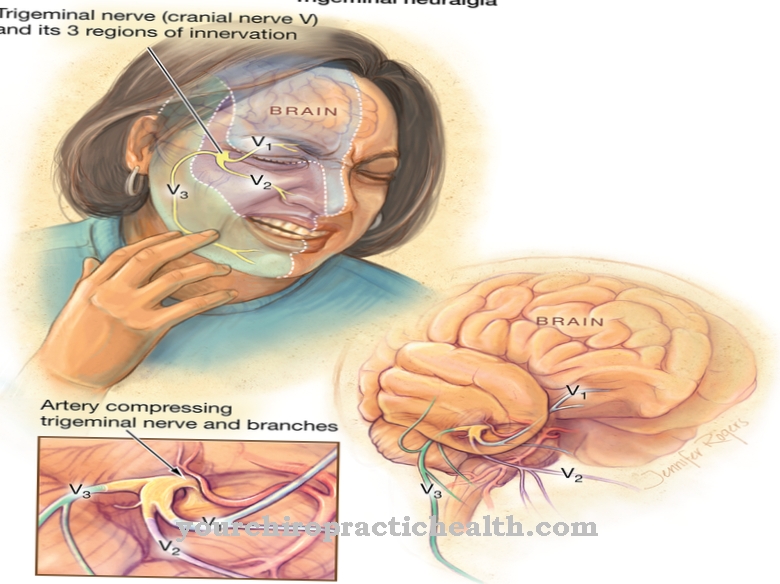The medical term Hypoparathyroidism refers to a disease caused by underactive parathyroid glands, which leads to a calcium deficiency due to insufficient release of the so-called parathyroid hormone. Which in most cases is caused by surgery on the thyroid gland Parathyroid hypofunction manifests itself through symptoms such as: hair loss, rough skin, muscle cramps, dementia or the formation of cataracts.
What is hypoparathyroidism?
.jpg)
© Henrie - stock.adobe.com
Of the Hypoparathyroidism is defined by a parathyroid hormone deficiency. The parathyroid glands, which usually consist of four small bodies, are located directly on the thyroid gland under the larynx and produce the parathyroid hormone.
This messenger substance, which in the case of hypoparathyroidism is only present in small amounts or not at all, on the one hand increases the amount of calcium in the blood and on the other hand lowers its phosphate concentration.
The parathyroid hormone deficiency caused by the underactive parathyroid gland has various negative effects, with which hypoparathyroidism can worsen and endanger both the physical and psychological condition of those affected.
causes
One of the most common causes of Hypoparathyroidism include surgery on the thyroid gland where the parathyroid glands were either removed by mistake or (due to radical thyroid removal) deliberately.
Because the parathyroid glands are next to the thyroid gland, accidental removal of the intact parathyroid glands (or parts of them) is relatively common. The blood flow to the parathyroid glands can also be disturbed in the course of the surgical procedure, which impairs the blood supply and, in the worst case, dies, which leads to hypoparathyroidism.
However, excessive intake of vitamin D over a longer period of time also inhibits the production of parathyroid hormone in the parathyroid glands and thus leads to hypoparathyroidism in the long term.
Furthermore, radiation carried out in the neck area (for example in the case of a malignant tumor) or a long-term deficiency in magnesium as well as the so-called DiGeorge syndrome (caused by defective parathyroid glands) are among the triggers of hypoparathyroidism.
Symptoms, ailments & signs
The symptoms of hypoparathyroidism are easy to spot. Due to the calcium deficiency, the conduction of stimuli between nerves and muscles is impeded, so that painful muscle cramps (spasms) occur. These are known as tetanic seizures. First of all, abnormal sensations such as tingling, tingling, painful burning, numbness or furiness on the forearms, hands or the mouth region occur.
As the disease progresses, muscle spasms develop with the hands in the paws that are typical of hypoparathyroidism, and less often with an equinus foot position. The cramping of the facial muscles creates a characteristic fish-mouth position. If other muscles are affected by the tetanic seizures, further symptoms can occur.
This can lead to shortness of breath if the respiratory muscles are affected. If the muscles of the internal organs such as the urinary bladder or the intestines cramp, this can trigger abdominal pain, diarrhea and an increased urge to urinate. It can also lead to anxiety, irritability, restlessness or depressive moods. In rare cases, those affected also experience epileptic fits.
If an underactive parathyroid is not adequately treated in childhood, long-term consequences such as changes in hair, skin and fingernails, cataracts, hair loss, tooth anomalies, motor disorders, calcification of the brain, the inner ear, the kidneys or the heart muscle, as well as growth and development disorders, can all occur occur for mild intellectual disability.
Diagnosis & course
The diagnosis of Hypoparathyroidism takes place on the basis of existing complaints and the determination of the calcium level as well as through examinations of the muscles and nerves.
The calcium deficiency caused by hypoparathyroidism causes various physical symptoms. Muscle cramps and sensory disturbances (tetanic syndrome) occur, which can lead to a so-called tetanic attack. Typical signs of such life-threatening attacks caused by hypoparathyroidism are tingling sensations in the hands and mouth as well as the urge to urinate, abdominal pain and diarrhea, followed by severe spasms of the muscles caused by an involuntarily contracted mouth (fish mouth), cramped hands and feet (paws and equinus foot) express, whereby those affected are usually fully conscious.
The spasms of the larynx, which sometimes also occur, can lead to life-threatening shortness of breath, especially in children suffering from hypoparathyroidism.
The excess of phosphate is also expressed by the muscles and nerves being easily excitable as well as by itching and reddened eyes. In addition, calcium deficiency and excess phosphate lead to a wide variety of symptoms such as hair loss, rough skin, calcification of the lenses of the eyes (cataracts) and the brain (dementia) in the case of untreated hypoparathyroidism, whereby the excess water that is also present in hypoparathyroidism can suddenly worsen vision.
Complications
The hypoparathyroidism leads to various symptoms and complaints, which usually depend on the severity of the disease. In most cases, however, the patients suffer from rough skin and hair loss. Furthermore, there is dementia and disorders of concentration and coordination. The affected person suffers from cataracts and severe pain in the muscles.
The everyday life of the person affected is restricted by hypoparathyroidism. Furthermore, sensory disorders can also occur in different regions of the body. In the worst case, this can even lead to paralysis and restricted mobility. The eyes are often red and itchy and the patient has difficulty breathing. The shortness of breath can lead to a loss of consciousness or damage to the organs.
Treatment of hypoparathyroidism is usually without complications. It quickly leads to a positive course of the disease and the symptoms disappear again. Complications usually only arise when treatment starts too late and organs have already been damaged. In most cases, this disease does not affect life expectancy.
When should you go to the doctor?
If muscle cramps, sensory disturbances, and other typical symptoms are noticed, a doctor should be seen within the next few days. Other warning signs that need to be clarified quickly are abdominal pain, diarrhea and tingling sensations in the hands and mouth, often accompanied by severe cramps, which are expressed by cramped hands, feet and mouth. Those affected usually feel severe pain and shortness of breath - symptoms that need to be clarified immediately.
Hypoparathyroidism is a life-threatening disease that can lead to dementia and various other complications in the further course. Those affected should go to the family doctor with the symptoms mentioned and, if necessary, visit a specialist clinic. If the disease is treated early, it is usually positive and the symptoms subside quickly. People with parathyroid disease or who have consumed too much vitamin D over a long period of time are particularly prone to developing hypoparathyroidism. Anyone who belongs to these risk groups must always seek medical advice.
Doctors & therapists in your area
Treatment & Therapy
Have the parathyroid glands been accidentally removed and so the Hypoparathyroidism triggered, they can be made to grow again by transplanting them into the patient's muscle tissue (usually in the neck or arm) and thus made them "ready for use" again.
This procedure, also known as autotransplantation, is also used as a preventative measure in the event of radiation to the neck area, insofar as the resulting damage (hypoparathyroidism) is to be expected. If this method is successful, the patient is considered cured for the time being, even if it is only a temporary solution in some cases.
If this form of treatment for hypoparathyroidism is not possible or does not work, medication is used. To compensate for the calcium deficiency caused by a lack of parathyroid hormones, hypoparathyroidism sufferers are given special calcium tablets with a low vitamin D content, which normalizes the amount of calcium in the blood and the symptoms caused by hypoparathyroidism usually disappear.
prevention
Since the Hypoparathyroidism In most cases, it is not caused by an improper diet or lifestyle, it is difficult to prevent. In any case, even if there are no signs of hypoparathyroidism, a possible magnesium deficiency as well as an excess of vitamin D should be excluded and a doctor examined.
Aftercare
Follow-up care for hypoparathyroidism is primarily intended to help compensate for the calcium deficiency. Therefore, the patients who suffer from an underactive parathyroid are prescribed appropriate calcium tablets with vitamin D. These agents are to be taken consistently in the aftercare phase so that the calcium level in the blood normalizes and the previous symptoms decrease.
In order to promote healthy development after the actual therapy, those affected should change their diet. Foods rich in calcium will help prevent the disease. Patients will soon feel more comfortable with dairy products, green vegetables and many types of nuts.
Too much fats and phosphates, on the other hand, are taboo, as they unnecessarily stress the organism. Those affected should also avoid alcohol. Light activities in the fresh air are also part of a healthy life. This increases wellbeing. Mindfulness and a good health awareness ensure that those affected also feel better psychologically.
This also applies to the case of a slight underactive parathyroid gland, which can quickly lead to stressful symptoms. A close observation of the physical warning signals helps to recognize an acute deterioration of the condition early and to avoid it effectively. Therefore, for a successful follow-up care, patients should carefully study the typical signs of the disease.
You can do that yourself
Parathyroid insufficiency complicates everyday life mainly through symptoms that can be traced back to hypocalcemia. The best possible prophylaxis option is a conscious, calcium-rich diet. Calcium-supplying foods such as dairy products, green vegetables (composites and cruciferous vegetables), and certain types of nuts should be the main component of meals. Avoid foods that contain fat and phosphates, as well as alcohol consumption. The bioavailability of calcium is only given in the presence of sufficient vitamin D, which is why daily, moderate exercise outdoors is advisable.
The general quality of life of patients improves several times through mindful nutrition. Mild hypocalcemia leads to moderate but psychologically distressing symptoms. Proper nutrition in combination with drug therapy can significantly reduce these symptoms. Severe hypocalcemia can usually only be treated as an inpatient. If those affected pay close attention to their physical warning signs, acute conditions can be effectively avoided.
Exhausting, sweaty activities remove important minerals from the body. In the case of increased physical activity, long excursions or working days, you can resort to the consumption of calcium-containing mineral water or calcium supplements. Carrying it with you and eating it not only reduces the risk of acute deficiency, but also reduces possible fears. As with any chronic illness, it helps to seek contact with other sufferers or to seek therapeutic help.


.jpg)










.jpg)

.jpg)
.jpg)











.jpg)